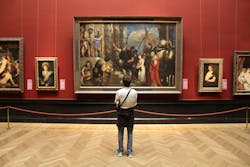SLC 2023 Preview: Seeing More Safely
Half of the human brain is involved directly or indirectly to processing visual information. Despite how many resources are anatomically devoted to sight, how much do we really see?
Not enough, argues Doug Pontsler, and that’s putting workers at risk. Pontsler is chairman and managing director of COVE: Center of Visual Expertise, which was created by the Toledo Museum of Art for the purpose of applying lessons from art education to industrial and service organizations with a focus on safety.
Below is a preview of what to expect from his presentation.
EHS Today: Can you explain what visual literacy is and why is it important for safety professionals?
Pontsler: Visual literacy is all about what we see, how we interpret what it means and what we do as a result. If you think about the role of a safety professional, a lot of what we do is look at work environments and human behaviors, looking for concerns and hazards that exist in the workplace.
The truth is that we are rarely trained on how to actually see what is around us. We rely on our natural abilities of how we look at things, and we are extremely confident that we see what is around us. This is despite the fact that we prove to ourselves frequently that this isn't true.
We can't see our car keys because they are somewhere different than normal, even if they are right in front of us. We can't find the ketchup bottle in the refrigerator, even though we know it is there. And in the workplace, things have become so familiar to us that we no longer see them, even the hazards.
You can think of [COVE’s] definition of visual literacy as a formula: The more we are able to see, the better our interpretation will be. The better our interpretation, the more meaningful and impactful the actions we take will be. Visual literacy should be a core competency for safety professionals and many others.
What can safety professionals learn from the art world?
Visual literacy is taught in art education in order to provide a framework for seeing. It so happens that the same approach to understanding a work of art applies to understanding the workplace as well.
We can leverage these same frameworks and tools, inside and outside the workplace, to see more detail and improve our understanding of the environment around us. People connect quickly with these concepts because we experience the challenges of now seeing effectively each and every day.
What does safety have in common with fine art?
More than you might think! It is all about how we make meaning from what we see. In art, it is attempting to understand what the artist was conveying in the work of art they created. We then decide whether we like it, or not, and whether it changes our perspective about something and perhaps our actions in the future.
This is much like what we do as safety professionals. We look at work environments to understand them. Are they safe? Are they unsafe? What actions should we take? The more detail that we see, the better our overall assessment will be—as will the actions that we take.
We see so much information each day, and we only process a small fraction of it. In fact, our brain sometimes goes on autopilot to help us conserve or devote our energy to solving those really challenging problems. How does visual literacy come into play while we perform everyday tasks?
It is so true that we are such a visual society. We are bombarded daily with images to interpret in our surroundings, our social media feeds and our communications via text or email. Everything is an image, even letters, words and numbers.
We are all very busy and anxious to get things done. As a result, we spend a great deal of time in our fast brain mode, automatically looking and interpreting without much conscious thought. While the brain is pretty good at this, it is not perfect, especially when conditions have changed.
For the work that we do as safety professionals, we need to engage our slow brain, which is more analytical and more thoughtful about what it is we are doing. Triggers to engage our slow brain can [include] starting a risk assessment, conducting a hazard hunt or engaging with an observation process. Visual literacy tools help us see and understand more, resulting in improved analysis and actions.
How can visual literacy help companies be more proactive about hazard identification?
Hazard identification is all about converting what we see to understanding whether it represents a hazard and, if so, how serious it can be so we allocate resources for mitigation appropriately. If we are visually literate, we understand how to see details more effectively, which can lead to a more complete hazard inventory and risk assessment.
We view visual literacy as a core competency that enhances our personal performance in all aspects of safety processes, such as hazard identification. After all, we can't fix what we don't see.
How can we teach or train others to see differently?
Our methodology at COVE is to teach visual literacy using a framework and tools from art education, and then [apply it] to industrial safety. We examine and practice using works of art, then apply to workplace environments using images and video.
In most cases, our live workshops are done in museums, where we can experience the works of art in a unique and interesting way, which makes the training fun and innovative. By understanding the framework and tools as practiced on works of art, we learn the same is actually true [when] looking at workplace examples and seeking understanding and interpretation. It is amazing that examining a Thomas Cole painting from 1840 can lead us to better examination of our workplaces as well. The tools are quite simple and can be immediately applied.
Given that many of your workshops are conducted in museums, do you find people are comfortable discussing safety in a museum environment?
Museums are a great environment for this type of training for several reasons, and participants quickly embrace the uniqueness that the training and the museum offers. Since we are leveraging lessons from art education in our training, museums are the perfect place to leverage the museum's collection to teach the principles and tools associated with visual literacy.
Conducting workshops outside of the workplace also creates a safe place for participants to engage and not be distracted with their normal workplace. Fun and innovative ranks high in participant feedback on our sessions.
How do you measure the effectiveness of visual literacy training since it’s teaching people how to be more proactive?
We can measure the effectiveness of visual literacy training both quantitatively and qualitatively. We survey workshop participants in several dimensions, including how they see the relevance of visual literacy to their work and [if they] would recommend visual literacy training or other safety and operational professionals. We receive over 90% support on each.
Comments provide additional support that the training is meaningful and impactful. Several clients have tracked as a leading indicator the impact on the number of hazards identified post training, with materially favorable results. COVE promotes leading indicator performance as a key measure of success [resulting in] improved risk management and safety performance.
What's one thing you hope attendees learn from your session at the Safety Leadership Conference?
I will actually give you three things. First of all, a good understanding of what visual literacy means. Second, why it matters to us, personally and professionally. And third, how visual literacy improves safety processes and safety performance. I promise a fun and engaging experience!
About the Author
Nicole Stempak
Nicole Stempak is managing editor of EHS Today and conference content manager of the Safety Leadership Conference.


